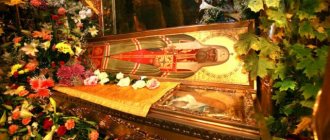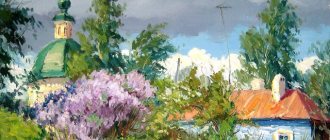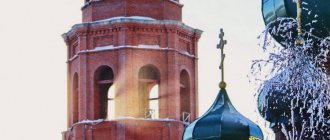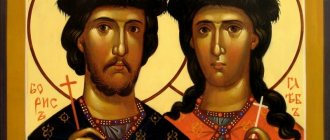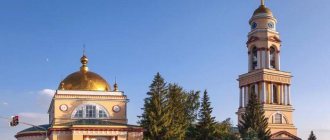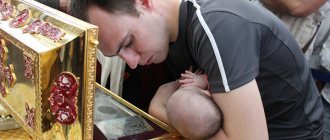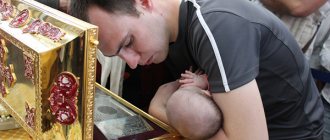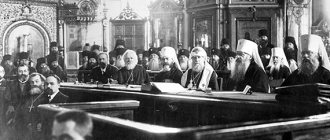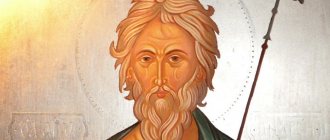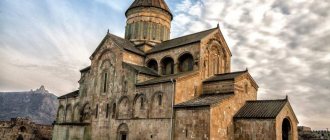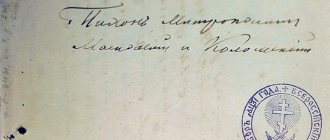Great preacher and healer
At the beginning of the 17th century, elders Cyril and Methodius from the Moscow Sretensky Monastery founded the Zadonsky Monastery of the Mother of God. Among the shady gardens, in the thicket of the forest, on the banks of the Don River, in the blessed silence, stands the monastery of God, where St. Tikhon arrived in 1769.
Icon of St. Tikhon of Zadonsk
Growing up in an extremely poor family and often starving as a child, the boy managed to graduate from theological seminary and took monastic vows in 1758, realizing his youthful dream.
The young man was distinguished by amazing patience, obedience and efficiency. Spiritual perfection contributed to rapid career growth. In 1759, Tikhon was elevated to the rank of hieromonk, and in 1761 he was already Bishop of Kexholm and Ladoga. In 1763, the saint headed the Voronezh diocese. Paying great attention to the fight against heresies and paganism, restoring seminaries and Sunday schools, receiving and praying for parishioners. Saint Tikhon constantly received parishioners, fed the poor, and personally gave the sick medicinal teas.
Read about the saint:
- Life of Tikhon of Zadonsk
- Akathist to Tikhon of Zadonsky
- Life of Tikhon of Zadonsk
A hungry and cold childhood made itself felt; the 40-year-old rector of the diocese was often ill and asked for his resignation, wanting to retire. The last refuge of the Monk Tikhon was the Zadonsk Monastery, in which the once rector of the diocese, having sold rich clothes and silver, distributed everything to the poor, lived like an ordinary monk, showing an example of patience, forgiveness and brotherly love.
Interesting! The brethren knew about his miraculous prayer during illness; often the monks were healed by his word alone. For his humility and reverence for God, the Creator rewarded the novice with the gift of clairvoyance; he predicted the time of his death, resting on August 13, 1783.
In the saint's notes, predictions of war with the French and the great St. Petersburg flood were found.
Temples of the monastery[edit]
- Cathedral of the Vladimir Icon of the Mother of God
- Refectory building with the Church of the Ascension of the Lord
- A bell tower with a three-altar church in honor of the Beheading of John the Baptist, St. Nicholas the Wonderworker and Hieromartyr Eusebius of Samosata.
- Church of Tikhon of Zadonsk and Ignatius the God-Bearer
- Church of the Nativity of the Virgin Mary with a chapel in honor of Her Tikhvin Icon.
- Church in honor of the icon of the Mother of God “Life-Giving Spring” and the martyr Agrippina.
- Gate Chapel
- Church of Tikhon of Zadonsk
- Chapel-bath at the source
The incorrupt relics of the saint
In 1845, during the construction of a new church, the tomb of the saint was opened, and his relics turned out to be incorrupt. Sacred joy and reverence gripped everyone present.
The priests were afraid of the large crowd of people and quietly carried out the reburial, which was performed in the Church of the Nativity of the Virgin Mary,
Only 16 years later, on the day of the death of St. Tikhon of Zadonsk, he was canonized. While the top cover was being removed, the temple, filled with several tens of thousands of people, froze in silence; the Christians slowly sank to their knees and froze in silent weeping.
Reliquary with the relics of Tikhon of Zadonsk
Terrible times awaited the Vladimir Monastery during the years of the revolution, when the Red Army soldiers opened the tomb and took the relics to Oryol, to the museum of religion. At the same time, they made a film supposedly exposing the incorruptibility of bones, calling everything a lie of religion.
All churches in Zadonsk were closed, many priests were either shot or sent into exile. The surviving monks, faithful to their shrine, returned to the holy place, and after Stalin’s permission to open the temples, they began worship.
By chance, Father Victor found an icon of Patriarch Tikhon in the attic of one of the houses, where he was drawn in full growth, which became the main shrine of the open church.
In 1959, a new commission was created, which confirmed the incorruptibility of the relics. The then ruler of the USSR, N.S. Khrushchev, did not like this; in 1961, the holy remains were again transferred to the museum’s storage facility.
Prayer to Tikhon of Zadonsk
O all-praised saint and saint of Christ, our Father Tikhon! Having lived like an angel on earth, you, like a good angel, appeared in your wondrous glorification. We believe with all our souls and thoughts that you are our merciful helper and prayer book, with your honest intercessions and the grace abundantly given to you from the Lord, ever contributing to our salvation. Accept therefore, blessed servant of Christ, even at this hour our unworthy prayer: free us through your intercession from the vanity and superstition that surrounds us, the unbelief and evil of man. Strive, quick intercessor for us, to beg the Lord with your favorable intercession, may He add His great and rich mercy to us, His sinful and unworthy servants, may He heal with His grace the incurable ulcers and scabs of our corrupted souls and bodies, may He dissolve our petrified hearts with tears of tenderness and contrition for our many sins and may He deliver us from eternal torment and the fire of Gehenna; May He grant to all His faithful people peace and quiet, health and salvation, and good haste in everything, so that having lived such a quiet and silent life in all piety and purity, let us be worthy to glorify and sing the all-holy name of the Father with the Angels and with all the saints, and the Son and the Holy Spirit forever and ever. Amen.
Feast of the Return of the Holy Relics
On August 26, 1991, bells filled Zadonsk. Along the flower-strewn road to the temple, in the presence of thousands of people, the holy relics of God's saint were returned to the monastery. It was a real celebration of God's miracle of healing. People suffering from long-term illnesses received instant healing after kissing the shrine containing holy relics.
Canopy over the relics of St. Tikhon in the Zadonsk Nativity of the Theotokos Monastery
An endless stream of prayers of thanks filled the monastery courtyard. People were healed in different ways:
- when kissing crayfish;
- after an appeal to the Holy One;
- when anointing with oil or simply standing in the temple;
- after reading the prayer.
Important! Many miracles of healing from incurable diseases were later documented by doctors.
How to get there[edit]
Directions:
There are different ways to get to Zadonsk. You can, for example, take a train from Moscow (from Paveletsky or Kursky stations) to Lipetsk, from there buses and minibuses go to Zadonsk. Alternatively: by train to Yelets, and then by bus. But it is most convenient to travel from Paveletsky station on the intercity bus “Moscow - Voronezh” - it has a stop in Zadonsk.
It is difficult to get lost in the city itself - it is small, and the crosses of the Zadonsk Monastery are visible from all points.
By car you need to leave Moscow along the M-4 Don federal road (distance about 400 kilometers). Zadonsk is clearly visible to the left of the highway - you should follow the sign for it. Over the bridge over the Don, the road leads directly to the Zadonsk monastery. If you want to visit the holy springs, then before reaching the monastery, you need to turn left at the crossroads. Just outside the city there will be the Tyuninsky Mother of God-Tikhonovsky Monastery with a spring; If you continue along this road, the sign (to the left) will show you the way to the source near the St. Tikhon's Transfiguration Monastery.
Address:
Lipetsk region, Zadonsk, st. Communes, 14.
Tel.:
8(47471)2-10-54,,,.
Official site.
Divine services in the monasteries of Zadonsk
The main action for which pilgrims go to Zadonsk is worship, the sacraments of Confession and Communion. The schedule of services of each monastery and church in Zadonsk has its own characteristics.
Schedule of services in Zadonsk monasteries:
| Time | Nativity of the Virgin Mary Monastery | Theotokos-Tikhonovsky Monastery (Tyunino) | St. Tikhon's Transfiguration | |
| St. Vladimir's Cathedral | Church of the Nativity of the Virgin Mary | |||
| 2:45 | Early liturgy (Sundays, holidays) | |||
| 5:40 | Sister's prayer service to Tikhon of Zadonsk | |||
| 5:45 | Middle liturgy (Sunday, holidays) | |||
| 6:00 | Morning prayers. Midnight Office. Akathist | Morning prayers. Midnight Office. Akathist to the icon "Life-Giving Spring" | Morning prayers. Midnight Office. | |
| 7:00 | Late Liturgy | Watch. Liturgy. Prayer services | ||
| 7:30 | Liturgy | |||
| 8:00 | Liturgy (Sunday) | |||
| 9:30 | Prayer service | |||
| 10:00 | Memorial service | |||
| 12:00 | Prayer service with akathist at the relics of St. Tikhon | |||
| 13:00 | Unction (Assumption Church, Saturday) | |||
| 16:00 | Evening service | Evening worship. Akathists | ||
| 16:40 | Vespers. Matins | |||
| 16:50 | All-night vigil with blessing of oil (Saturday, holidays) | |||
Advice. In all the monasteries of Zadonsk you can order services: remembrance of health and repose, magpies, prayer services with an akathist and blessing of water, the Indestructible Psalter. It is more convenient to register them on the monastery website than to stand in a long line and waste precious time during the pilgrimage.
Holy Trinity Convent
The beginning of the fourth Zadonsk monastery was laid by a hospice house for the care of infirm wanderers who came to worship the shrines of Zadonsk. In 1860, at the community of sisters of mercy, a church was built in honor of the icon “Joy of All Who Sorrow.” The maiden community received the status of a monastery in 1888. The people called the monastery “Sorrowful” until the Church of the Life-Giving Trinity was erected, which became the throne for the monastery.
The Holy Trinity Convent existed until 1929. Of the buildings of the former convent, only the 5-domed Church of the Life-Giving Trinity (Trinity Cathedral) remains - an architectural monument of the 19th century. This is the only place in Zadonsk where newlyweds are married and children are baptized.
Church of the Life-Giving Trinity
St. Tikhon's Transfiguration Monastery
7 kilometers from the Bogoroditsky Monastery, on a hillside in the forest, the St. Tikhon Monastery hid from prying eyes.
St. Tikhon's Transfiguration Monastery (photo: sezenovo-mon.ru)
250 years ago, Saint Tikhon called this place “earthly paradise” - he founded a monastery here, dug a well, prayed and worked on the book “Spiritual Treasure Collected from the World.” Immediately after Tikhon’s canonization, a new monastery was founded in his honor in the wilderness on the banks of the Prokhodnya River. In 1920, the Tikhonov Zadonsky Monastery was destroyed, literally wiped off the face of the earth. But after 70 years, life began to flare up in it again. In April 1991, nuns became nuns of the “earthly paradise.” The gate church of the Transfiguration was the first to be restored, and the monastery received the name: St. Tikhon's Transfiguration Convent. On its territory there are three churches - Trinity, Preobrazhensky and Assumption, there is a hotel for pilgrims, and a bathhouse at the Holy Spring.
Y. Demyanov “Red Summer”
The revival of the monastery was accompanied by miraculous signs that strengthened the spirit of the sisters who worked for the glory of God:
- The cell of St. Tikhon arose on the site of a dilapidated turret in the wall. Once passing by it in a religious procession, all the sisters smelled the wonderful smell of incense there. It was decided to build a chapel in the corner tower in memory of Tikhon’s prayerful solitude and spiritual labors. The chapel is called the Cell of Tikhon of Zadonsk.
- The Iveron Icon of the Mother of God is an image that arrived at St. Tikhon’s Skete from Mount Athos even before the revolution. During the Soviet years, the holy icon served as a door in a barnyard until it found its way into a God-loving family. Three generations later, family members carried the holy relic and transferred it to the Tikhonovsky Monastery, not suspecting that this was its rightful place. The Iveron Icon is in the Trinity Collection - it streams myrrh, heals and gives parental happiness to childless families.
- In 2000, a Bleeding Crucifixion appeared in the Tikhonovsky Monastery: droplets of blood leaked from under the crown of thorns, on hands pierced with nails. This happened on the day of remembrance of all Russian saints. Today the wonderful relic is in the Assumption Cathedral of St. Tikhon's Monastery.
- The Stone of Health is a place to which many pilgrims come with prayer and hope for healing and receive what they ask for. It is assumed that under the stone there is a burial of the incorruptible relics of one of the former inhabitants of the monastery. The stone lies not far from the chapel on the site of the former monastery cemetery.
Today, about a hundred sisters live in the Tikhonovsky Transfiguration Monastery. Through their efforts, the place of the solitary exploits of Tikhon of Zadonsk became a real paradise on earth for many hundreds of people.
St. Tikhon's Transfiguration Monastery
Official website of the monastery https://zadonsk-skit.ru.
Architecture, appearance and interior decoration of monastery churches
The Zadonsk Monastery of Tikhon of Zadonsk, which survived many years of persecution and devastation, today sparkles with new domes of churches that are visible from all corners of the small town of Zadonsk, Yelets region.
Not all restoration work has been completed yet, but the main buildings perform their functions and decorate the courtyard of the renewed monastery.
Cathedral in honor of the Vladimir Icon of the Mother of God
Vladimir Cathedral, consecrated in 1853, is called by experts “a smaller copy of the Moscow Cathedral of Christ the Savior.” This is not surprising, because the author of his project is the famous architect, creator of the main Moscow cathedral and many famous buildings - Konstantin Andreevich Ton. The iconostasis for the temple was provided by the artist T.E. Myagkov.
“The Heart of the Nativity of the Virgin Mary Monastery,” is what believers call the Vladimir Cathedral.
The eight-limits temple of the Vladimir Icon, made in the Russian-Byzantine style: a three-story, slender, upward-facing building. Its outer walls are plastered and painted blue and white.
The wall painting, made at the end of the 19th century by the famous Moscow artist K.E. Morozov and his team, was taken from the interior decoration of the Cathedral of Christ the Savior and supplemented with scenes on the life and glorification of Tikhon of Zadonsk.
The best of the wall paintings are considered to be “The Last Supper”, located in the altar part of the cathedral, a copy of a painting by the artist Semiradsky, as well as “The Nativity of Christ”, copied from a painting by the artist Vereshchagin. Time has been kind to the rare decoration of the temple; the frescoes were completely restored.
Moscow specialists from V.A.’s workshop worked on this problem in 1990-94. Naumova. After the completion of the stage of work by Moscow artists, the painting of the temple was continued by Yelets specialists. In 2006-2007, they painted icons placed in the new iconostasis.
During the restoration of the temple, talented monks of the monastery took an active part in the artistic work. Their creations, written with awe and love, decorate the supporting pillars, walls and iconostasis of the cathedral.
Refectory Church in honor of the Ascension of the Lord
The church was opened in 1817 during the renovation of the refectory building. The room where the brethren ate food became too small over time and did not have a prayer room. During its expansion, it was decided to open a winter church here, which was located on the second floor. Being in the same building as the refectory, the Church of the Ascension is sometimes called the same.
During the Soviet era, a vegetable drying plant operated in good premises. The restoration of the temple became possible in 2000. The work proceeded slowly, the dilapidated frescoes were recreated with the talent and effort of the monks themselves. When the wall painting of the church was completed, the monks again set about creating the iconostasis and painting icons for it with their own hands. The consecration took place in 2021.
Temple in honor of the Icon of the Mother of God “Life-Giving Source”
Outside the monastery walls, right next to the fence, a spring gushes out of the ground, which has long been considered holy. Here, to the base of the hill on which the Mother of God Monastery rises, Saint Tikhon often came and prayed in peace and quiet. Legend says that as a result of his appeals to God, a miraculous spring began to flow, but in fact, the source has been here since ancient times.
This is what local residents say, but there are no documents on this matter. It is known that the first chapel appeared here in 1730 at the direction of the governor Euthymius. After 140 years, it had become so dilapidated that it had to be dismantled. The newly built church was consecrated with one altar: the image of the Mother of God “Life-Giving Spring”. Inside there was a font into which streams from the holy spring flowed.
In the 60s of the last century, the temple was demolished and the well walled up. Over many years, this place was covered with earth, overgrown with turf and bushes. When at the end of the 20th century enthusiasts tried to find the treasured place, even the old-timers did not help. The foundation was found only with the help of instruments. Based on the surviving photographs, it was possible to restore the temple with the font in the cleared area.
The plastered building is painted in the colors of the main cathedral - white and blue. Later the heating was installed. The painting and iconostasis were done by Yelets masters. Today, services for health are held in the church on holidays and Sundays, starting at 13-00.
Temple in honor of St. Nicholas of Myra the Wonderworker
The Zadonsky Monastery of Tikhon of Zadonsk is famous throughout the city for its magical bell ringing. The construction of the slender bell tower was headed by the architect I.A. Blitsyn. It was completed in 1835, lasting more than 10 years. A cast-iron slab with an inscription of gratitude addressed to Emperor Alexander II was mounted in the belfry's base.
At the bottom of the structure there was a three-altar church with a main altar, consecrated in the name of St. Nicholas the Pleasant (of Myra). The height of the bell tower is 82 m, its facade is richly decorated with stucco molding, columns, sculptures and other decorative elements. The bell tower has a through passage - this is the “Holy Gate”, the entrance to the monastery during celebrations. The arch above the gate is painted with scenes from the lives of the founders of the monastery.
Since 1989, the bell tower together with the Church of St. Nicholas is included in the list of cultural monuments, and the state took up its reconstruction. At the top, the structure ends with a 22-meter spire and a 5-meter cross. A modern clock with chimes is mounted on the upper tier. The decorative finishing of the building was restored and external lighting was installed.
In addition to the temples listed above, the territory includes:
| Temple name | Year of construction | Year of restoration |
| In the name of the Nativity of Our Lady | 1835 | 2016 |
| In honor of St. Tikhon of Zadonsk at the place of his burial | 1870 | 2017 |
| In honor of St. Tikhon of Zadonsk on the site of his cell | 1865 | 2016 |
Where to stay
The three-story Zadonsk hotel opposite the monastery is the simplest solution to the issue of spending the night in Zadonsk. It offers rooms of the “Lux”, “Comfort”, “Economy” types, costing from 750 to 5000 rubles. per person. Hotel address – st. Communes, 13.
Pilgrims of the Nativity of the Virgin Mary Monastery can stay at the hotel on Lenina, 28 - two hundred meters from the monastery. The cost of an overnight stay is 600-1000 rubles. per person.
Other accommodation options in Zadonsk can be found here.
In the monastery itself, a social hotel has been operating for almost 30 years: you can stay within the monastery walls completely free of charge, but for a short period of time. Accommodation inside the monastery provides for mandatory participation in divine services and performing feasible obediences.
Advice: if you want to attend a night monastery service, take the opportunity to spend the night in the social hotel of the Bogoroditskaya monastery. All other accommodation options will not allow you to enter the monastery territory at night.
Zadonsk Map
When planning to visit Zadonsk, take the time to study the city map with streets and house numbers. She will tell you a lot of interesting things about the history of the city and help create an interesting walking route.
Since the time of Catherine II, Zadonsk has been built strictly according to plan, with the streets oriented to the cardinal points. The bed of the Teshevka River divides the city into 2 parts: Northern – Dvoryanskaya and Southern – Meshchanskaya. The longest streets of the city stretch parallel to the Don from south to north: Karla Marx (formerly Dvoryanskaya Street) and st. Krupskaya (formerly Sobornaya).
The main temples of the city occupy dominant heights, reflecting the development of the city from south to north.
The Assumption Cathedral (15 Uritsky St.) is the center of the Meshchanskaya Sloboda; Zadonsk fairs were held on Market Square in front of the cathedral.
The famous “golden Lenin” stands here, pointing with an energetic gesture at the magnificent ensemble of the Bogoroditsky Monastery (Kommuny St., 14).
Following from the monastery along K. Marx Street, we see the flaming Trinity Cathedral (K. Marx Street, 85) and further on the horizon rises its twin - the Ascension Cathedral in Tyunino (beginning of K. Marx Street).
Tip: find an object on the Zadonsk route with the address: st. M. Gorky, 34. Here is an amazing landmark of the city - the Singing Oak, which streams myrrh, sings akathists and heals people. Anyone who takes the time to find this place and reach it can touch the Mystery.
Mother of God-Tikhonovsky (Tyuninsky) Monastery
The location of this monastery is also associated with the name of Tikhon of Zadonsk, who fell in love with a spring in the wilderness, 3 kilometers from the Zadonsk Monastery. The source was ennobled and equipped by the hands of the saint - it is the main shrine of the women's monastery. In 1814, a house church was built here in honor of the “Life-Giving Spring” icon. The complex of the Tyuninsky Monastery (the name comes from the name of the landowner - the owner of these lands in the 17th century) in addition to this temple includes the majestic Ascension Cathedral, the Church of Alexander Nevsky, a four-tier bell tower, and a pilgrim's house. The monastery is home to 30 sisters, headed by Abbess Arsenia.
Mother of God-Tikhonovsky (Tyuninsky) Monastery
Official website of the Tyunin Monastery: https://tunino.ru.
